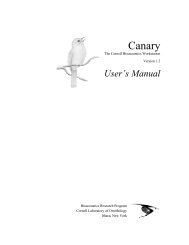A Land Manager's Guide to Improving Habitat for Forest Thrushes
A Land Manager's Guide to Improving Habitat for Forest Thrushes
A Land Manager's Guide to Improving Habitat for Forest Thrushes
You also want an ePaper? Increase the reach of your titles
YUMPU automatically turns print PDFs into web optimized ePapers that Google loves.
14<br />
sites with Veeries were located in mixed <strong>for</strong>est, 44%<br />
in deciduous <strong>for</strong>est, and 1% in coniferous <strong>for</strong>est. The<br />
most common trees on sites occupied by Veeries were<br />
maples (73%), oaks (60%), pines (28%), American<br />
beech (21%), and hemlock (20%).<br />
Results from this study indicate that Veeries are<br />
most affected by the degree of fragmentation in the<br />
landscape and by the size of <strong>for</strong>est patches, especially<br />
the amount of “core <strong>for</strong>est” away from edges. The most<br />
suitable sites are also those with a denser deciduous<br />
shrub unders<strong>to</strong>ry. Highest-suitability habitat only occurs<br />
in landscapes with at least 70% <strong>for</strong>est cover, and<br />
in these landscapes, patches larger than 1,000 acres<br />
(400 ha) are required (Table 1). Even in landscapes<br />
with 80% <strong>for</strong>est, patches of roughly 400 acres (165 ha)<br />
are required; minimum area is reduced <strong>to</strong> 127 acres<br />
(51 ha) if <strong>for</strong>est cover increases <strong>to</strong> 90%. Smaller <strong>for</strong>est<br />
patches in more fragmented landscapes do provide<br />
moderate habitat suitability, however, patches greater<br />
than 300 acres (120 ha) are still required in landscapes<br />
with 40% <strong>for</strong>est.<br />
Other studies suggest that Veeries use a variety of<br />
habitats in different parts of their range. In New York<br />
State, Veeries select early successional <strong>for</strong>est <strong>for</strong> breeding<br />
(Kendeigh 1945, 1946). In highland areas of North<br />
Carolina, it’s a bird of mature oak <strong>for</strong>est (Odum 1950)<br />
and on Apostle Island in Wisconsin, it’s found primarily<br />
in aspen and red oak <strong>for</strong>ests where the unders<strong>to</strong>ry is<br />
most dense (Beals 1960). In New Jersey, Veeries prefer<br />
moist <strong>for</strong>ests that are 40–60 years old with a dense<br />
unders<strong>to</strong>ry (Suthers 1987–1988).<br />
Unlike the other <strong>for</strong>est thrushes, Veeries show a<br />
strong <strong>to</strong>lerance <strong>for</strong> disturbed <strong>for</strong>est with a well-developed<br />
unders<strong>to</strong>ry (Dilger 1956). Noon et al. (1976)<br />
found that Veeries bred in 77% of available disturbed<br />
and successional <strong>for</strong>ests, but only 18% of mature<br />
Table 1. Minimum area required <strong>to</strong> provide high,<br />
moderate, or low habitat suitability <strong>for</strong> Veery<br />
based on analysis of 685 study sites in the East/<br />
Midwest region (see page 11 <strong>for</strong> definitions of<br />
habitat suitability).<br />
Percentage<br />
of <strong>for</strong>est in<br />
2,500-acre<br />
block<br />
Minimum area (acres)<br />
required <strong>for</strong><br />
High Moderate Low<br />
90 127 3 Any size<br />
80 396 10 Any size<br />
70 1004 26 Any size<br />
60 NA a 61 1<br />
50 NA 136 2<br />
40 NA 305 4<br />
30 NA 708 9<br />
20 NA NA 24<br />
10 NA NA 74<br />
a Not Available—acreage values exceed the amount of <strong>for</strong>est in<br />
the 2,500-acre block.<br />
undisturbed habitat. Bertin (1977) suggested that in<br />
mature woodlands, moisture regime was the primary<br />
fac<strong>to</strong>r driving habitat selection, with the dampest areas<br />
occupied first and pointed <strong>to</strong> available shrub cover<br />
as the most critical habitat component. Veeries may<br />
benefit from selective harvesting that opens up the<br />
canopy and allows the unders<strong>to</strong>ry <strong>to</strong> develop (Webb<br />
et al. 1977, Thompson and Capen 1988). Derleth et al.<br />
(1989) found that Veeries <strong>to</strong>lerated small clearcuts (2–<br />
20 acres or 1–8 ha), but Morgan and Freedman (1986)<br />
noted that Veeries were absent from large clearcuts <strong>for</strong><br />
six years following the harvest.<br />
<strong>Habitat</strong> selection may vary when other thrushes<br />
are present. In many portions of their range, Veery<br />
breed primarily in deciduous <strong>for</strong>est, even when coniferous<br />
<strong>for</strong>est is available. In a study conducted in Tennessee,<br />
in areas where their breeding range overlapped<br />
with Swainson’s Thrush, the Veery used deciduous,<br />
coniferous, and mixed <strong>for</strong>ests (Noon 1977). Although<br />
it was once absent from higher elevation spruce <strong>for</strong>ests<br />
in the Appalachian Mountains, Veerys have expanded<br />
in<strong>to</strong> the southern Appalachian spruce <strong>for</strong>ests when<br />
congeners are not present (Noon 1981).<br />
Hermit Thrush<br />
In the East/Midwest <strong>Forest</strong> Region, Hermit<br />
<strong>Thrushes</strong> are restricted largely <strong>to</strong> the northernmost<br />
portions and also <strong>to</strong> higher elevations through the<br />
Appalachians where coniferous <strong>for</strong>ests are dominant.<br />
Small populations occur in other coniferous habitats at<br />
lower elevations, including cedar swamps, hemlock ravines,<br />
conifer plantations, and pine barrens. Although<br />
this thrush is common and apparently increasing, it<br />
is nonetheless shown <strong>to</strong> be highly area sensitive and<br />
in<strong>to</strong>lerant of <strong>for</strong>est fragmentation within its range.<br />
In the Birds in <strong>Forest</strong>ed <strong>Land</strong>scapes study, Hermit<br />
Table 2. Minimum area required <strong>to</strong> provide high,<br />
moderate, or low habitat suitability <strong>for</strong> Hermit<br />
Thrush based on analysis of 347 study sites in the<br />
East/Midwest region (see page 11 <strong>for</strong> definitions<br />
of habitat suitability).<br />
Percentage<br />
of <strong>for</strong>est in<br />
2,500-acre<br />
block<br />
Minimum area (acres)<br />
required <strong>for</strong><br />
High Moderate Low<br />
90 32 5 Any size<br />
80 56 9 1<br />
70 88 14 1<br />
60 132 22 2<br />
50 196 32 3<br />
40 289 47 4<br />
30 435 71 6<br />
20 NA a 111 10<br />
10 NA 193 18<br />
a Not Available—acreage values exceed the amount of <strong>for</strong>est in<br />
the 2,500-acre block.

















